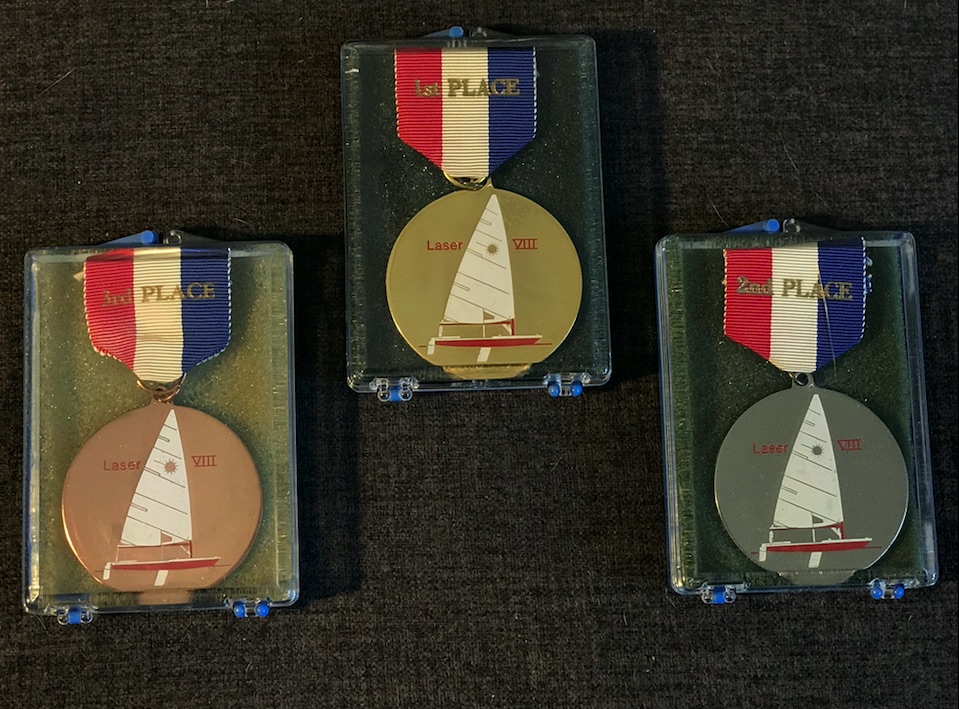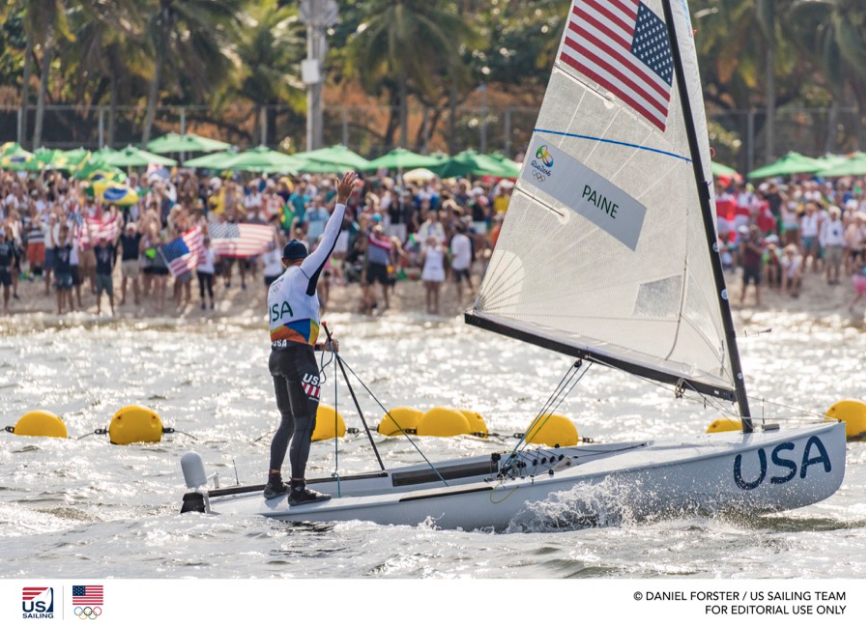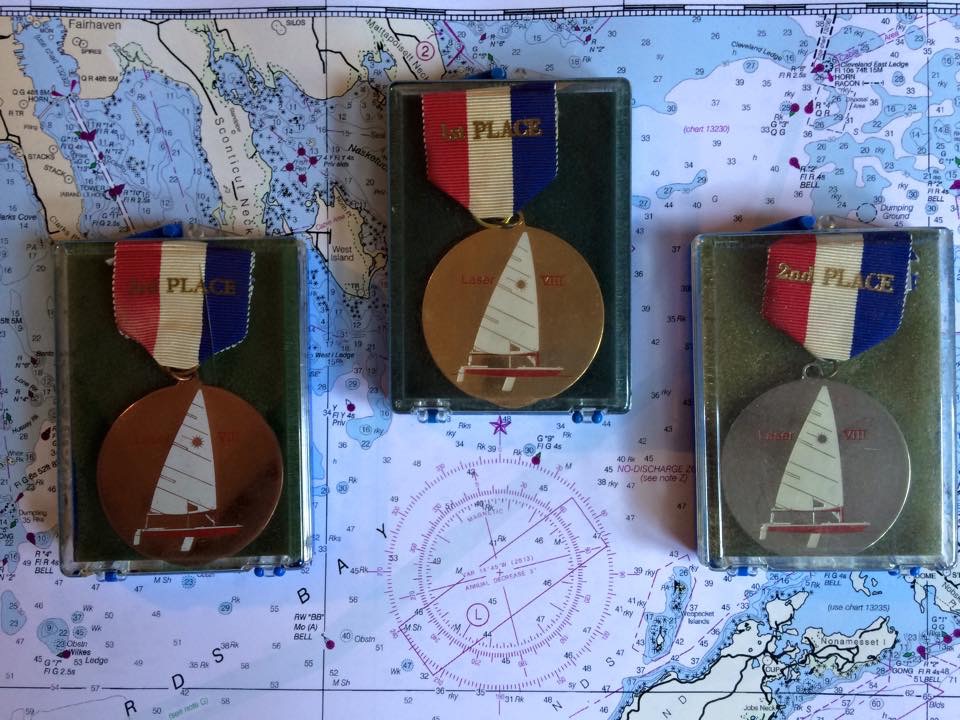If you race a boat often enough, that number never fades away even if you forget how to sail a boat well.
Pro athletes are often synonymous with their jersey numbers. Most big fans of major league players probably know their faves’ numbers. Those numbers are often retired with the players themselves.

Not the same for sailing; even though there’s a little bit of team racing out there, and a few true rock-star sailors, it’s the boat – not the sailor – that is identified on the course. For most racing, it’s the sail number. It can be random, or it can be the number of the boat that came out of the mold (hull #1 would say just “1” on the sail, or maybe “001”). It’s used to identify boats for scoring or penalty purposes.
I’ll never forget my sail numbers. I raced two boats actively enough for enough time that I have them. Sadly, I can’t find photos of my father or in the boats detailed below, but they might be hiding in one last storage area. Anywho…
#228: my Dyer Dhow

My first dinghy (and the first time I ever sailed one) was my Dyer. Funny story about how I got it:
Sometimes Dad had strange ideas about what made for a good birthday gift. That might have been due to forgetting my birthday – never knew for sure. One year, he said that he was giving me one of the sailing school boats. (He owned and operated a major sailing school and that was my introduction to the industry.) Great! I was too young to realize what it did and did not mean.
Years later, I got interested in racing, and then read an article in Yacht Racing & Cruising (now just Sailing World). It was in their how-to series, “From the Experts.” Here, champions in their respective boat classes dished on how to deliver. They shared their secrets on how to get the best performance out of the boat. I forget the author’s name. This got me interested in frostbiting, or racing boats in the winter months here in the northeast.
I asked my folks if they’d get me a Dyer so I could do this. No.
I somehow remembered about my sailboat gift: hadn’t thought of it for years. I leveraged it. My boat, but..? How many classes did your school teach on it? How much rental income was there from it? I did some gymnastic arithmetic that was at least roughly based on reality. I can up with a bill: you gave me this boat, then used it for profit. Here’s what you owe me.
He knew he’d been had. Mom didn’t intervene, which meant she agreed with me. Next week, he bought me a new Dyer Dhow. I remember going to Sobstad Sailmakers in Mamaroneck (a solid regional sailmaker at the time, perhaps national, with good racing pedigree). They had the deal to make all the sails for Mamaroneck Frostbiting Association’s Dyer Dhow fleet. Truly one-design; all sails were identical. You could opt for an aluminum mast instead of the standard wood one. You could “Harkenize” your boat: use all Harken turning blocks instead of whatever shit Dyer installed. That, and your choice of rope material for the mainsheet and outhaul, maybe halyard, and hiking stick. None of that made any significant difference. You had to sail the boat better than your competitors.

Anyway, I was #228, and I named the boat Dyer Straits. (I was a Dire-hard Mark Knopfler fan.) I remembered the number due to the sheer number of times I looked at it and heard it through a bull horn on the race courses. (“228, you’re over early.” “228, we have your finish.” (DFL, or dead fucking last…) “228, nice race!” (I did win some).
Dad was not about to be undone. He drove me to the frostbiting. Eventually he borrowed my boat from time to time. He might have sailed a race or two by swapping out with me at the committee boat on some days. But, of course, he eventually got his own.
#501: Apocalypse Dhow!
He probably wore Levis’ 501 jeans as well. Big on denim and a Willie Nelson looking bandana.
A year or three later, I wound up trying a Laser in the Virgin Islands. They had them for rent at Bitter End Yacht Club in Virgin Gorda. I’d never sailed one. But, I knew how to. Why? Another “From the Experts” article: Laser, by Olympic Finn contender and one of the top Laser sailors at the time, Carl Buchan (whose Dad, Billl, was a champion in the Star keelboat class). I knew how to throw the boat around with my body by torquing at the hips with torso as lever. I knew how to hike out, and get the boat up on a plane quickly by handling the sheet properly to pump the sail. I knew were the daggerboard should be. I capsized once… but flipped the boat back up easily as I’d read about it.
I sailed the boat back to the beach up on a plane, skimmed way up past the shoreline, pulling up the dagger board just before I grounded. Hopped off and gave it back to dad.
Dad secretly bought a new one for me soon afterward. But, mom didn’t think I deserved it, and told him to not give it to me. He couldn’t hide the boat, nor could he satisfactorily explain why I couldn’t use it. (I didn’t know at first about mom’s interference.) So, eventually, he let me try it. Then, more often. Somehow he sort of stopped using it so I just kept doing it, and boom – it was my boat.
#101670, no name.
Yup: at the time, they’d make over 100,000 Lasers. That was in the early 1980’s; now that the boat has been active in the Olympics for a long time, I shudder to think what the hull count has gotten up to. But, I’ll always remember 101670.
My boat was stolen 5 or 6 years later. That was that. I filed a police report, and still almost remember the name of the female officer who took the complaint as I had an instant crush on her (Jimenez or Rodriguez; probably former as I new a Rodriguez or two from HS & college so might have them crossed up). But the sail number remains!
I started sailing and racing Lasers again two years ago at Sebago Canoe Club in Canarsie (sailing dinghies abound in addition to paddle craft). I added Sunfish and a Vanguard 15 (which is like a big Laser with a jib.) Maybe I’ll take a club sail with minimal or no numbers on it and resurrect mine. I’ll be easy to ID when called over early or rounding a mark the wrong way.
Old habits die hard…

LINKS..
LASER! “There is no substitute.” And, “There’s nothing you can’t do on a Laser.”


















